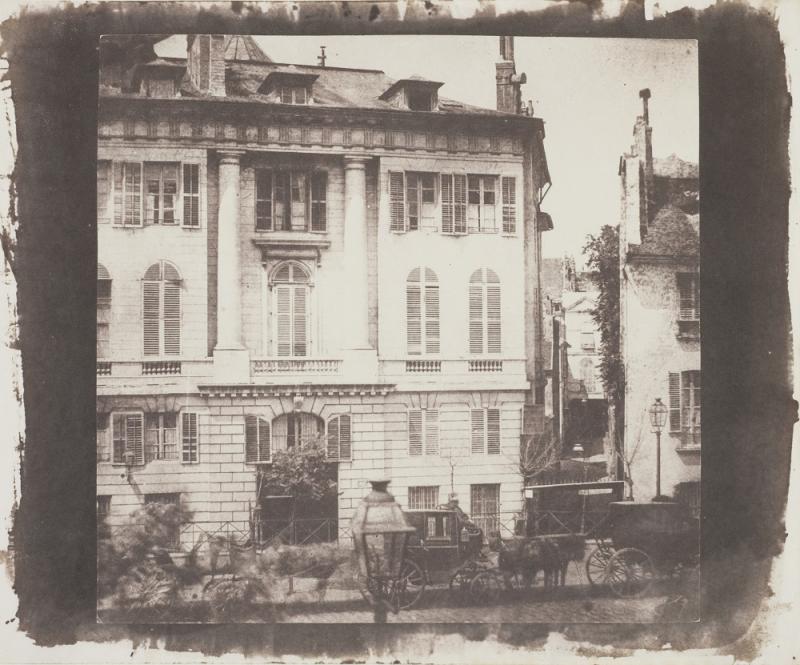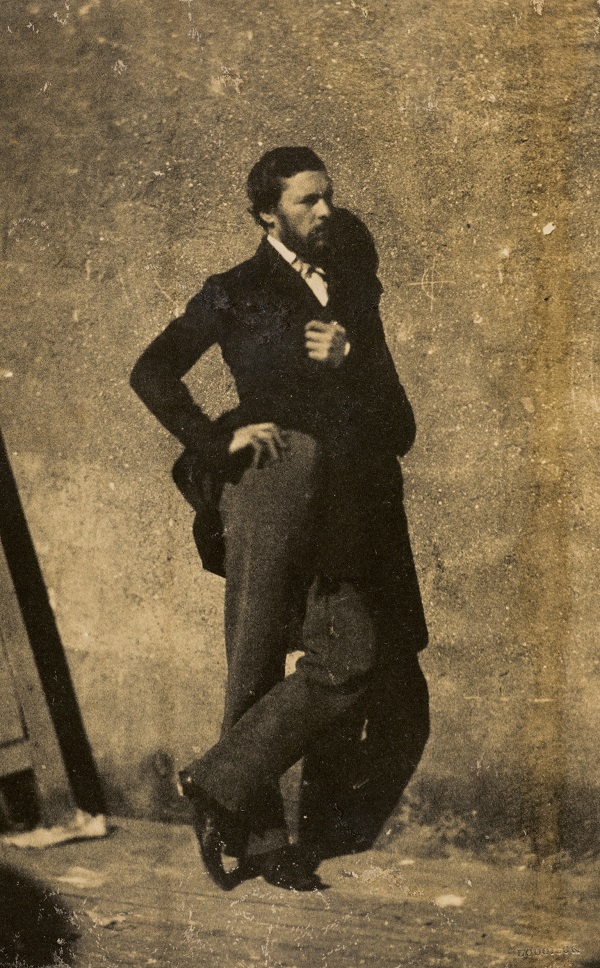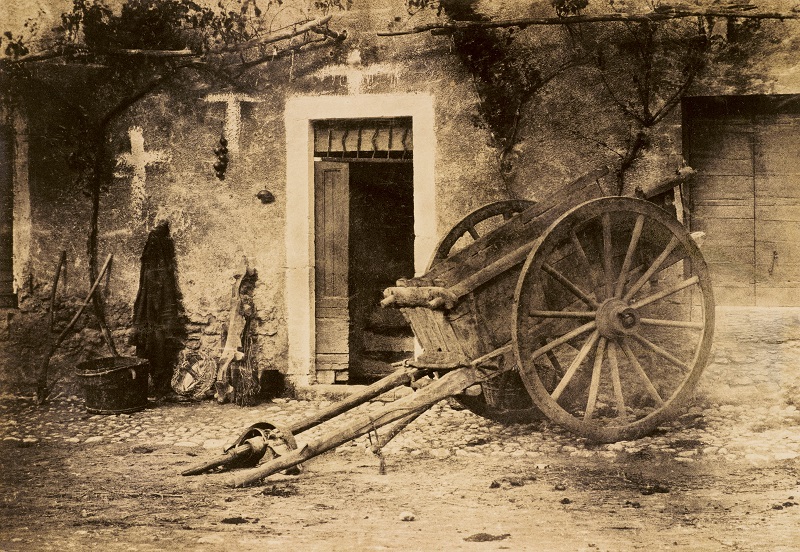Salt and Silver, Tate Britain | reviews, news & interviews
Salt and Silver, Tate Britain
Salt and Silver, Tate Britain
Early photographs that brim with the spirit of experimentation

Captured in monochromes ranging from the most delicate honeyed golds to robust gradations of aubergine and deep brown, the earliest photographs still provoke a shiver of surprise and excitement. Even now, their very existence seems miraculous, and the blur of a face, or the lost swish of a horse’s tail signifies the photographer’s pitched battle with time, never quite managing to make it stop altogether.
By 1839, William Henry Fox Talbot in England and Louis-Jacques-Mandé Daguerre in France had each found quite different means by which to “fix a shadow”, the evocative terms through which Talbot himself described his invention. Talbot’s method, using light-sensitive paper to produce a negative which could then be printed as a positive, produced an image considerably less refined than Daguerre’s unique positive image, but its reproducibility would become one of photography’s defining characteristics. Lacking the near-perfect resolution of the daguerrotype, Talbot’s salted paper prints had an aesthetic appeal of their own, a softness and a velvety depth that speaks to the sensibilities of painting and drawing. Developed by Talbot as a means of overcoming his own lack of drawing ability, the salt print quickly gained currency as an expressive medium.
 Talbot’s early photographs are brimming with the spirit of experimentation, and in his choice of subjects – friends and family, street scenes and natural objects – he busily explores photography’s potential, testing its limitations and acquiring a new-found wonder at the world as it could be represented in the new medium.
Talbot’s early photographs are brimming with the spirit of experimentation, and in his choice of subjects – friends and family, street scenes and natural objects – he busily explores photography’s potential, testing its limitations and acquiring a new-found wonder at the world as it could be represented in the new medium.
His careful arrangements of china and glass serve both as a scientific experiment and a promotional tool. They allowed him to note the differing exposure times required by china and glass and the light-reflecting properties of different colours, observations that would become significant when trying to judge exposure times out in the field. But perhaps more surprisingly to our modern eyes, the pictures show that a transparent object could indeed be successfully photographed and that unlike drawing, multiple objects could be recorded in the time that it would take to photograph just one. The comparison with painting and drawing is there again in Talbot’s beautiful image of a tree in the dead of winter, each branch and hair-like twig picked out as if to say, “now imagine how long it would take to draw that".
By 1841, Talbot had dramatically reduced, from many minutes to just seconds, the exposure time needed to produce a negative, and on a trip to Paris to publicise his new calotype process he took a picture from his hotel room window, an instinctive piece of photojournalism (main picture). The buildings opposite are rendered in precise and exquisite detail, the black and white stripes of the shutters neat alternations of light and shade. In contrast to the solidity of the buildings are the carriages waiting on the street below; the wheels, immobile, are seen in perfect clarity, while the skittish horses are no more than ghostly blurs.
As growing numbers of pioneers adopted Talbot’s invention and began photographing the world around them, portraiture emerged early on as a genre, and in a variety of forms. We see the beginnings of the stiff Victorian portrait but more surprising are the very many experimental and informal images that were produced. A group of fishermen, their faces, modelled in blocks of light and shade, seem to have been caught candidly, and yet they must have been standing still for some time. And in his portrait of a man lent against a wall, Louis Crette allows his subject’s shadow as much substance as his clothing, the deep velvety black contrasting with the rough texture of the wall (Pictured above right: A Lesson of Gustave Le Gray in his Studio, 1854).
Just as portraiture showed little regard for social class or traditional ideas of beauty, so the camera treated all aspects of modern life with an even hand. In the decades before Impressionism, photographers marvelled at the world around them in all its manifestations, photographing the new industrial architecture, and devastated, flood-damaged buildings with the same care as they took over images of revered ancient buildings.
 Even in these early years, one of photography’s enduring problems became evident, however. One of the most beautiful photographs in this exhibition is Paul Marès Ox Cart, Brittany, c.1857 (pictured left). At first it seems a picturesque scene of bucolic tranquillity, the abandoned cart an exquisite study in light and tone. But on the cottage wall are painted two white crosses, a warning – apparently even as recently as the 19th century – to passers-by that the household was afflicted by some deadly disease. Photography’s ability to indiscriminately aestheticise is a dilemma that has continued to present itself ever since, especially in the fields of reportage and war photography.
Even in these early years, one of photography’s enduring problems became evident, however. One of the most beautiful photographs in this exhibition is Paul Marès Ox Cart, Brittany, c.1857 (pictured left). At first it seems a picturesque scene of bucolic tranquillity, the abandoned cart an exquisite study in light and tone. But on the cottage wall are painted two white crosses, a warning – apparently even as recently as the 19th century – to passers-by that the household was afflicted by some deadly disease. Photography’s ability to indiscriminately aestheticise is a dilemma that has continued to present itself ever since, especially in the fields of reportage and war photography.
In fact, this relatively small group of pictures could almost serve as a manifesto proclaiming the concerns that would dominate photography in the 20th century, and in defining the new medium barely a stone was left unturned in these first 20 years. Beautifully hung, and with minimal distractions from accompanying texts, the curators have boldly and quite rightly decided that the technical details can be dispensed with, widely available as they are on the internet and in books.The only thing to do here is look.
Share this article
Add comment
The future of Arts Journalism
You can stop theartsdesk.com closing!
We urgently need financing to survive. Our fundraising drive has thus far raised £49,000 but we need to reach £100,000 or we will be forced to close. Please contribute here: https://gofund.me/c3f6033d
And if you can forward this information to anyone who might assist, we’d be grateful.

Subscribe to theartsdesk.com
Thank you for continuing to read our work on theartsdesk.com. For unlimited access to every article in its entirety, including our archive of more than 15,000 pieces, we're asking for £5 per month or £40 per year. We feel it's a very good deal, and hope you do too.
To take a subscription now simply click here.
And if you're looking for that extra gift for a friend or family member, why not treat them to a theartsdesk.com gift subscription?
more Visual arts
 'We are bowled over!' Thank you for your messages of love and support
Much-appreciated words of commendation from readers and the cultural community
'We are bowled over!' Thank you for your messages of love and support
Much-appreciated words of commendation from readers and the cultural community
 Photo Oxford 2025 review - photography all over the town
At last, a UK festival that takes photography seriously
Photo Oxford 2025 review - photography all over the town
At last, a UK festival that takes photography seriously
![SEX MONEY RACE RELIGION [2016] by Gilbert and George. Installation shot of Gilbert & George 21ST CENTURY PICTURES Hayward Gallery](https://theartsdesk.com/sites/default/files/styles/thumbnail/public/mastimages/Gilbert%20%26%20George_%2021ST%20CENTURY%20PICTURES.%20SEX%20MONEY%20RACE%20RELIGION%20%5B2016%5D.%20Photo_%20Mark%20Blower.%20Courtesy%20of%20the%20Gilbert%20%26%20George%20and%20the%20Hayward%20Gallery._0.jpg?itok=7tVsLyR-) Gilbert & George, 21st Century Pictures, Hayward Gallery review - brash, bright and not so beautiful
The couple's coloured photomontages shout louder than ever, causing sensory overload
Gilbert & George, 21st Century Pictures, Hayward Gallery review - brash, bright and not so beautiful
The couple's coloured photomontages shout louder than ever, causing sensory overload
 Lee Miller, Tate Britain review - an extraordinary career that remains an enigma
Fashion photographer, artist or war reporter; will the real Lee Miller please step forward?
Lee Miller, Tate Britain review - an extraordinary career that remains an enigma
Fashion photographer, artist or war reporter; will the real Lee Miller please step forward?
 Kerry James Marshall: The Histories, Royal Academy review - a triumphant celebration of blackness
Room after room of glorious paintings
Kerry James Marshall: The Histories, Royal Academy review - a triumphant celebration of blackness
Room after room of glorious paintings
 Folkestone Triennial 2025 - landscape, seascape, art lovers' escape
Locally rooted festival brings home many but not all global concerns
Folkestone Triennial 2025 - landscape, seascape, art lovers' escape
Locally rooted festival brings home many but not all global concerns
 Sir Brian Clarke (1953-2025) - a personal tribute
Remembering an artist with a gift for the transcendent
Sir Brian Clarke (1953-2025) - a personal tribute
Remembering an artist with a gift for the transcendent
 Emily Kam Kngwarray, Tate Modern review - glimpses of another world
Pictures that are an affirmation of belonging
Emily Kam Kngwarray, Tate Modern review - glimpses of another world
Pictures that are an affirmation of belonging
 Kiefer / Van Gogh, Royal Academy review - a pairing of opposites
Small scale intensity meets large scale melodrama
Kiefer / Van Gogh, Royal Academy review - a pairing of opposites
Small scale intensity meets large scale melodrama
 Jenny Saville: The Anatomy of Painting, National Portrait Gallery review - a protégé losing her way
A brilliant painter in search of a worthwhile subject
Jenny Saville: The Anatomy of Painting, National Portrait Gallery review - a protégé losing her way
A brilliant painter in search of a worthwhile subject
 Abstract Erotic, Courtauld Gallery review - sculpture that is sensuous, funny and subversive
Testing the boundaries of good taste, and winning
Abstract Erotic, Courtauld Gallery review - sculpture that is sensuous, funny and subversive
Testing the boundaries of good taste, and winning
 Edward Burra, Tate Britain review - watercolour made mainstream
Social satire with a nasty bite
Edward Burra, Tate Britain review - watercolour made mainstream
Social satire with a nasty bite

Comments
This exhibition runs until 7
Yes, you are quite right -
Yes, you are quite right - thank you for pointing that out. It has been corrected now.